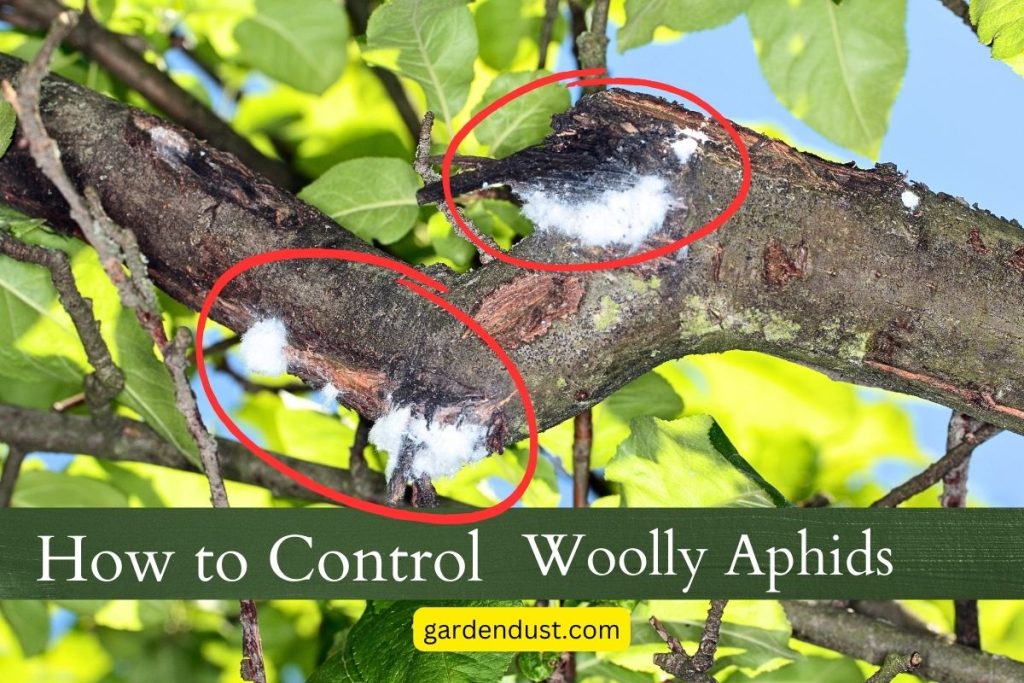Woolly aphids, scientifically known as Eriosomatinae, are tiny, sap-sucking insects that can wreak havoc on various plants, particularly fruit trees and ornamental shrubs. Characterized by their woolly appearance due to a waxy secretion, these pests can quickly multiply and damage plant tissues. Controlling woolly aphids is crucial for maintaining a healthy garden and preventing long-term damage to your plants. In this comprehensive guide, we will delve into various strategies of How to Control Woolly Aphids for effectively managing and preventing woolly aphid infestations. Let’s start…
How to Identify them
Woolly aphids are known for their protective wax, which shields them from predators and pesticides. The waxy coating makes them resistant to conventional control measures, requiring a more strategic and persistent approach to eliminate them from your garden.
It’s crucial to correctly identify woolly aphids. These pests can be identified by their small size (usually 1-2 mm), a woolly or cotton-like appearance, and a range of colors, including green, brown, or pink. They are often found in clusters on the undersides of leaves, stems, and branches.
It’s also essential to understand the life cycle and habits of woolly aphids. These pests often target fruit trees such as apple, pear, and cherry, as well as ornamental plants like roses and euonymus. Woolly aphids feed on plant sap using needle-like mouthparts, causing wilting, yellowing, and distorted growth in their host plants.
7 Methods-How To Control Woolly Aphids
1. Natural Predators and Biological Control
Encouraging natural predators is an effective and environmentally friendly way to control woolly aphids. Ladybugs, lacewings, and parasitic wasps are natural enemies that feed on aphids. Introducing these predators to your garden can help establish a balance in the ecosystem and keep aphid populations in check.
Additionally, consider introducing beneficial nematodes to the soil. These microscopic organisms prey on woolly aphids and their larvae, providing long-term control without harming other beneficial insects.
2. Horticultural Oils and Insecticidal Soaps
Horticultural oils and insecticidal soaps are effective tools for controlling woolly aphids, especially in the early stages of infestation. These products work by suffocating the pests, disrupting their protective waxy coating. When applying these treatments, ensure thorough coverage, targeting the undersides of leaves and the aphid clusters.
It’s essential to use horticultural oils and insecticidal soaps during the early morning or late evening to avoid harming beneficial insects, as these products may also affect non-target species.
3. Neem Oil as an Organic Solution
Neem oil, derived from the neem tree, is a natural and organic solution for controlling woolly aphids. Neem oil disrupts the aphids’ feeding and reproductive processes, making it an effective and environmentally friendly option.
To use neem oil, mix it with water and a small amount of dish soap to enhance its effectiveness. Apply the solution to the affected plants, ensuring thorough coverage. Repeat the application every 7-10 days until the aphid infestation is under control.
4. Pruning and Removing Infested Plant Parts
Pruning and removing infested plant parts is an essential step in controlling woolly aphids. Since these pests often cluster on stems and branches, carefully prune and dispose of heavily infested areas. This not only removes a significant portion of the aphid population but also enhances air circulation, creating an unfavorable environment for their reproduction.
Regularly inspect your plants and promptly prune any new growth showing signs of woolly aphid infestation. Be sure to dispose of pruned material away from the garden to prevent the aphids from reinfesting nearby plants.
5. Systemic Insecticides for Severe Infestations
In cases of severe woolly aphid infestations where natural and organic methods may not be sufficient, systemic insecticides can be considered. These insecticides are absorbed by the plant, making them toxic to aphids when they feed on the sap.
When using systemic insecticides, follow the manufacturer’s instructions carefully, and be cautious about potential impacts on beneficial insects. Keep in mind that systemic insecticides are not the first line of defense and should be used as a last resort when other control methods prove inadequate.
READ ALSO:-How to Get Rid of Slugs in the Garden
6. Companion Planting for Aphid Repellent
Companion planting involves strategically placing plants that repel aphids near those susceptible to infestation. Plants like chives, garlic, and marigolds are known to deter aphids due to their strong scents. By incorporating these repellent plants into your garden, you create a less attractive environment for woolly aphids.
Consider interplanting these repellent species among your fruit trees and ornamental plants, forming a natural barrier that can help prevent aphid infestations.
7. Regular Monitoring and Early Intervention
Regular monitoring of your garden is crucial for early detection and intervention against woolly aphids. Inspect the undersides of leaves, stems, and branches regularly for signs of infestation, such as the characteristic woolly appearance and sticky honeydew secretions.
Early intervention, whether through natural predators, horticultural oils, or insecticidal soaps, can prevent the rapid spread of woolly aphids and minimize the damage to your plants.
Controlling woolly aphids requires a multifaceted approach that combines natural predators, organic solutions, and proactive garden management. By understanding the life cycle of woolly aphids and implementing a combination of these strategies, you can effectively manage and prevent infestations, ensuring a healthy and thriving garden.
Remember to tailor your approach based on the severity of the infestation and the specific plants affected. With diligence and a comprehensive control plan, you can protect your garden from the damaging effects of woolly aphids and enjoy a vibrant and pest-free outdoor space. Happy Gardening…







